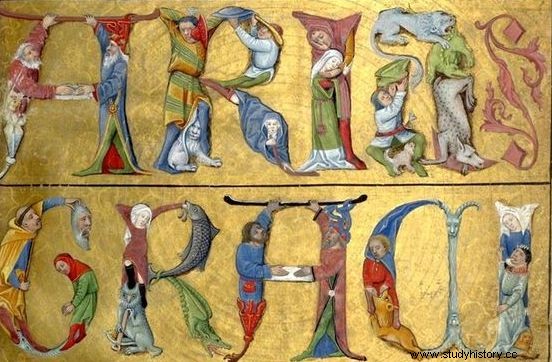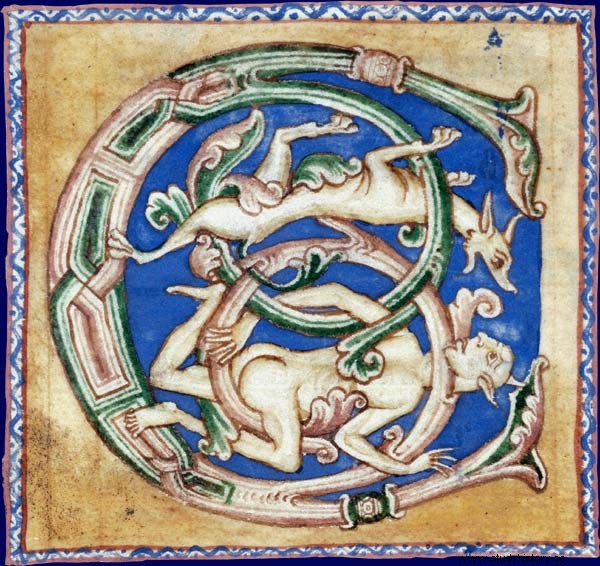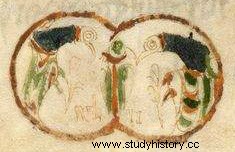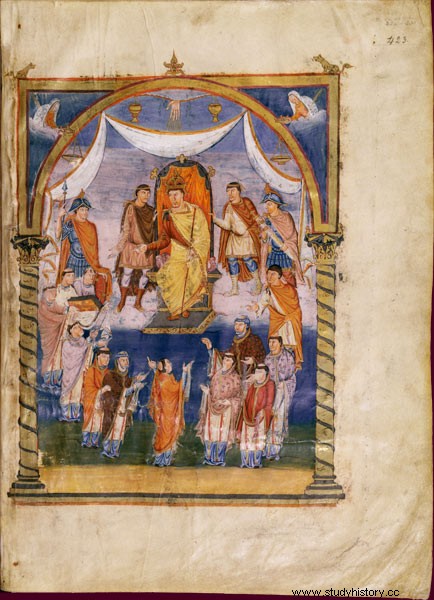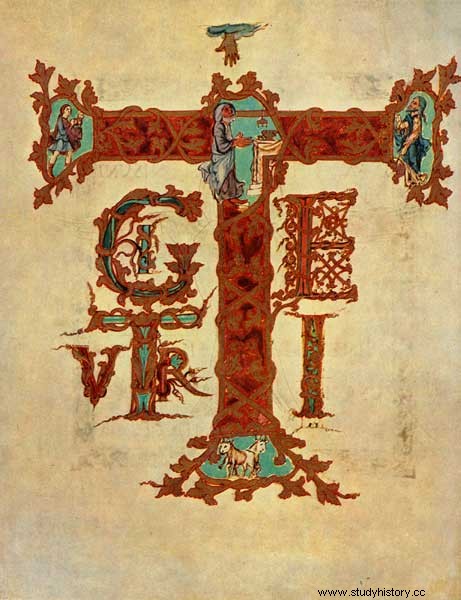The illumination and more particularly the illuminated letters are something other than a vulgar formatting. Attention to detail and precision are two characteristic elements of this way of highlighting a piece of writing. This art which gives so many colors to the writings was born in the Middle Ages when the books began to develop in the form of "codex". We decide to pay particular attention to the layout, the details, the letters. For 1200 years, illumination developed and different styles emerged, depending on historical periods and ruling dynasties:
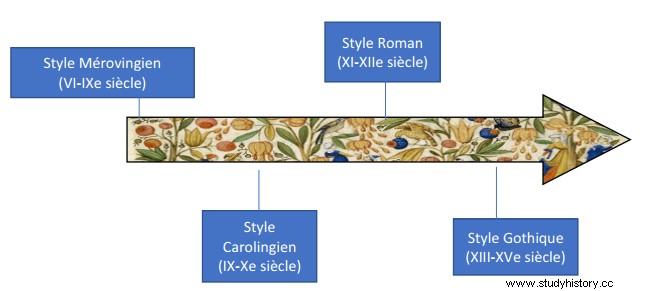
A decor with a thousand faces and functions
Illumination was born at the same time as the book we know today and it is a typical medieval practice widespread in the countries of Western Europe. The illuminated decor has a considerable influence both on the reader and on the layout itself. The illumination is primarily used to articulate the text, to determine the paragraphs:the reader can therefore better find his way around. The illuminated decoration therefore does not only have a purely decorative effect:it is an element of the layout in its own right. In this way, the books will acquire structures little by little thanks to chapters, sections or even paragraphs. The illumination therefore plays a double game:it informs the reader about the text and vice versa.
The decor has its own existence and it is the artist who will decide what role the illumination will play:symbolic, historical, aesthetic, utilitarian, etc. The different types, styles and decorative elements correspond to periods and allow us today to be able to precisely date the works. All types of works are illuminated but the Bible, which is the most read book in the Middle Ages will also remain the most illuminated. With the appearance of an apparent structure of the book, the decoration and its specificities will also be subject to a hierarchy which is expressed by technical differences such as size, colors or even the technique used:painting takes precedence over the drawing, the metals on the colors, the image on the ornament, the large on the small. These elements make it possible to date and determine the workshop in which the work was produced.
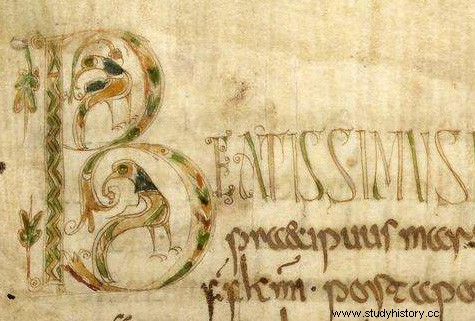
The different types of illuminations
In the Merovingian period, illumination is characterized by the presence of an important bestiary. Fish and birds are the most represented. Geometric patterns, spirals, interlacing and shimmering colors will brighten up text borders. The first representations of human figures in illuminations appear at the very end of this period. Tools like the compass and the ruler are obligatorily used for the realization of the initials. In France, the monastery of Luxeuil produced the Lectionary of Luxeuil, the most beautiful illuminations of this period.
The Carolingian era (9th – 10th centuries) gives a central place to writing and books and it is Charlemagne who will decide to include writing in the whole life of the kingdom. Charlemagne reorganizes the institutions and the methods:he will govern by writing capitularies which will spread throughout the kingdom. In addition, he reformed the teaching which will now focus on studying sacred and ancient texts. Within churches, convents or monasteries, groups of scholars will direct places of production of manuscripts. In terms of the materials used, these were very expensive:gold or silver ink, ivory plates, goldsmithing, etc. Regarding the iconography linked to this period, foliage and animals are still very present. It is at this time that the "historiated" letter develops:a character tells a story inside this letter. Different schools emerge and produce ever more accomplished works, filled with details and colors such as the Sacramentary of Drogon (2) produced by the school of Metz or the Bible of Charles the Bald from the school of Tours (1) .
Between the 11th and 12th centuries, illumination first developed in France and England. The workshops of the north of France are those which produce the works of beautiful invoice like Arras, Tournai, Amiens. The spread of the Romanesque style is partly due to the Order of Cluny and the Carthusians who required all their members to be monks and copyists. At that time, illumination and decoration took up more and more space within the works. The "mat pages" and "full page" paintings appear. Bright colors are also present. It is no longer the image that comes in addition to the text to specify it but it is the text that adapts to the image taking up all the space. Zoomorphic initials, which are difficult to read, will also develop.
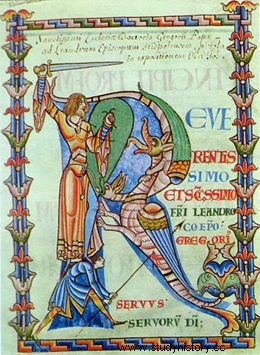
Between the 13th and 15th centuries, it was the golden age of illumination. With more and more schools and universities, more and more books are needed. Workshops will then multiply in the cities in order to produce a greater number of copies. In addition, books become objects of art and luxury, in great demand. In terms of the forms that illuminations could take, more and more "medallions" appeared, especially because at the same time stained glass was developing. The iconography will be composed of many hybrid and strange animals. Thanks to the improvement of the technique, the bodies of the characters and the fabrics will be much more flexible and fluid. As far as colors are concerned, the palette will expand thanks to a desire to apply more and more different shades and tones.
Animals:a recurring motif
Animals will be present daily during the Middle Ages, so it is not surprising to encounter them as illustrations in manuscripts. We are going to talk about a certain idea of cohabitation between man and animal. Indeed, the animals will be useful for man on different aspects such as the sheep which will allow him to be fed, as well as to dress him but also to create parchments for the books like the feathers of birds will be useful. in the manufacture of tools for making manuscripts. Animals will also participate in the labor force before the invention of machines and will be present during human activities such as fishing or hunting. We will see in this last area an expression of character specific to certain animals like cunning, or the intelligence of the animal or the faithfulness concerning the dog. This interest in characteristics in animals will lead to the appearance of bestiaries, i.e. books grouping together different animals in a specific order, generally starting with the lion, then wild animals, followed by domestic animals and "little heads" which include birds and insects. In the bestiaries, the artist represents a figurative illustration of the animal followed by a description in Latin or French.
In addition, some representations of strange animals will appear, particularly between the 13th and 15th centuries, we will talk about being hybrid. The hybrid being is recognizable by its representation, in fact the artist will create a mixture of different parts of the body, sometimes human but generally animal. The idea is to recognize the different animals used, the illuminator will recover elements allowing the animal to be easily recognized such as feathers, scales, fur or even claws. We are going to talk about Marginalia or humor which aims to distract, amuse the reader. Concerning the artist, by realizing these hybrid beings, he realizes a search for aesthetics, for the pleasure of assembling animal traits in order to invent a new form.

It should not be forgotten that illuminations were mainly present in religious works. This is why certain representations of animals will have a hidden meaning. For example the deer will have a Christological vision. Indeed, it is assimilated to a life that is perpetuated, to a rebirth. It is sometimes represented in the idea of the resurrection of Christ. The lamb will also incarnate Christ in an idea of sweetness, purity and sacrifice like Christ. There is also the butterfly, representing the idea of transubstantiation because it is able to draw its terrestrial attachment in order to rise towards the heavens. Idea confirmed by its Greek origin “Psyché” which means the soul. The Bible will also give an important place in writing for animals as in creation or with Noah, so it is important to illustrate with the animals that are mentioned from the beginning of the Bible. Animals will also be present in the tetramorph which is associated with the four evangelists with Mark for the lion, Luke for the bull, Matthew for the angel and John for the eagle, again invoking characteristics found in the evangelists as well as in animals. This image is found in the apocalypse of Saint John “ “Before the throne, it looks like a sea, as transparent as crystal. In the middle of the throne and around it stand four Living Ones, studded with eyes in front and behind. The first Living is like a lion; the second Living is like a young bull; the third Living has the face of a man. The fourth Living is like an eagle in full flight. The four Living Ones, each bearing six wings, are studded with eyes all around and within. »
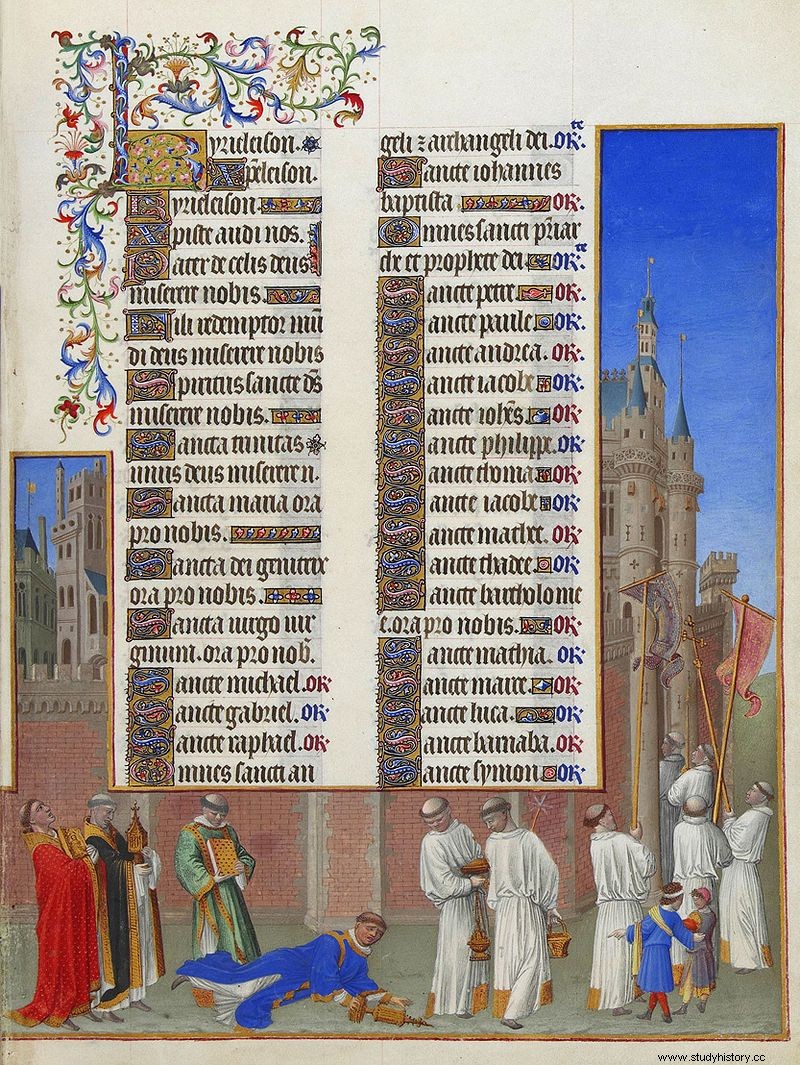 Folio 72 recto des Très Riches Heures du Duc de Berry, Limbourg brothers (1410/1416) France
Folio 72 recto des Très Riches Heures du Duc de Berry, Limbourg brothers (1410/1416) France At a time when machines have taken control, as G.Orwell would say, the art of illumination allows us to admire what patience and work do best.

